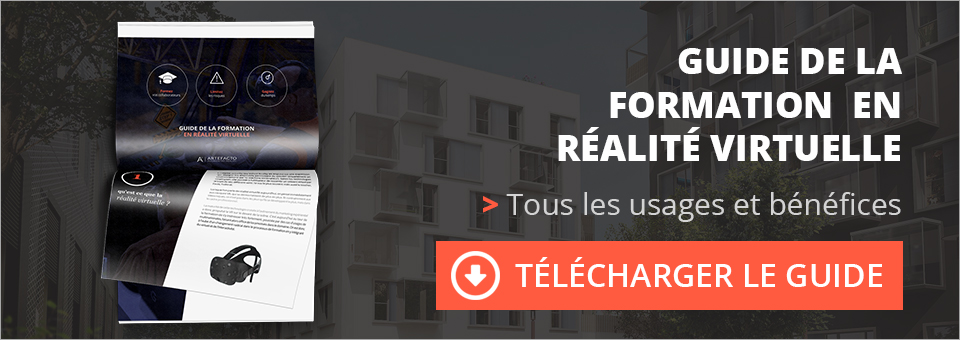La formation en réalité virtuelle vous intéresse mais vous doutez encore de ses possibilités et de ses usages ?
Après vous avoir présenté plusieurs cas d’usage de multinationales ayant choisi la réalité virtuelle pour former ses salariés, avec le géant Walmart en tête, il nous paraissait intéressant de vous proposer une interview d’un expert de ce domaine. Marwan, spécialiste de la formation en VR chez Artefacto répond aux questions les plus fréquemment posées à ce sujet.

Bonjour Marwan, pour commencer, peux-tu te présenter brièvement ?
Je suis chef de projet formation VR chez Artefacto. Concernant mon parcours, cela remonte à mon enfance ! J’ai toujours été passionné par l’informatique et je suis tombé dedans très jeune ! Je suis diplômé en ingénierie informatique. J’ai ensuite eu la chance d’effectuer un stage dans la VR et je suis tombé amoureux de cette technologie. J’ai alors entrepris en parallèle une thèse en comportement artificiel. Cela m’a fait découvrir un côté plus ludique de la technologie. Pendant ma thèse, j’ai donné des cours et cela m’a donné envie d’enseigner ou du moins, de me diriger vers le domaine de la formation. Pour allier mes deux passions, je me suis alors orienté vers le « serious game », c’est-à-dire le développement de jeux vidéo en réalité virtuelle intégrant une dimension pédagogique. Je travaille actuellement sur énormément de sujets différents : formation pour les bouchers, les garagistes…. Un projet marquant que j’ai développé il y a quelques années : une simulation de gestion de foule pour la police espagnole !
Comment la VR est devenue aussi populaire ? Qu’offre-t-elle comme possibilités ?
La VR a toujours été populaire chez les gros industriels. J’ai commencé en 2001 et la techno était déjà répandue, notamment pour le prototypage mais cela coûtait très cher. Le grand public n’a pu profiter de ces innovations technologiques que récemment. Les nouveaux smartphone sont en effet permis de démocratiser et miniaturiser l’affichage, les détecteurs de mouvements, etc. On doit la VR actuelle notamment grâce au créateur de l’Oculus Rift, Palmer Luckey. Il a réussi à dynamiser le marché actuel et cela a permis à la VR d’exploser. Mais la techno était déjà prête depuis longtemps !
Pourquoi la réalité virtuelle est-elle une bonne solution pour la formation ?
L’atout majeur de la VR, c’est la mise en situation. On ne regarde pas une vidéo, on ne lit pas un texte. Là, on est directement projeté dans un environnement… et on y croit visuellement ! Même si on est loin de ce que l’on peut voir dans les films de science-fiction, il n’en reste pas moins qu’on est immergé. D’un point de vue cognitif, les informations sont mieux perçues, et, compte tenu du réalisme de l’environnement, on est plus amené à effectuer les vrais gestes que l’on ferait dans la vie. Après, cela ne peut pas remplacer un véritable entrainement physique car l’immersion n’est pas parfaite : celle-ci est visuelle et sonore, mais pas encore haptique, par exemple. Toutefois la formation en VR est bien plus efficace qu’une formation théorique car elle permet de mémoriser plus facilement des process.
Justement, quels-sont les bénéfices par rapport à une formation classique ?
Généralement, pour se former à une machine industrielle, il faut être mis en situation physique. La formation en VR permet, par exemple, de ne pas bloquer une machine de production pour effectuer l’entrainement. Ce type de formation est également bien plus sécurisant. Typiquement, avec le nucléaire, il n’y pas de risque d’accident grave. Un autre avantage d’une solution en VR, c’est la répétabilité : on peut refaire une action plusieurs fois pour mieux l’enregistrer et faire des erreurs tout en réalisant des manipulations dangereuses, par exemple. Cela évite également de faire le déplacement si le lieu d’entrainement est éloigné. La VR permet d’être sur site, de se familiariser avec les lieux avant de réellement se rendre sur le terrain.
J’ai un autre exemple en tête. Chez Disney, ils utilisent la VR pour le prototypage des nouvelles attractions et de la décoration. Ils simulent, projettent et vérifient la validité d’une attraction avant qu’elle soit construite. On est clairement dans l’anticipation et donc, dans un gain financier potentiel.
Comment réagissent les personnes immergées dans la réalité virtuelle ?
Généralement, la première réaction, c’est juste « Wouah ! ». Les gens sont bluffés, ils ne s’attendent pas à ça. Il y en a pour qui cette impression continue même après de nombreux essais. Certaines personnes sont fatiguées au bout d’un certain temps parce que cela reste une expérience où les sens sont dupés et mis à l’épreuve ; d’autres personnes vivent mal cette déconnexion vis-à -vis de la réalité. Quoi qu’il en soit, avec les dernières versions de casques, ce genre de ressenti est moins répandu car il y a moins de décalage entre la réalité et le virtuel.
Quelles-sont les limites de la formation en VR ?
On parlait de duper les sens… Le problème, c’est que cela ne trompe que la vue et l’ouïe, or, on a d’autres sens ! On ne peut pas toucher et ressentir le monde virtuel. Même si certaines technologies commencent à aller dans cette voie, ce n’est pas encore tout à fait au point. Les déplacements aussi ne sont pas encore réellement simulés. Par exemple, pour vraiment se former à un métier comme dans l’artisanat, il est important d’être dans le réel et utiliser le reste de ses sens, en particulier le toucher ou encore l’odorat. Les technologies haptiques ne sont pas encore suffisamment au point selon moi.
Enfin, selon toi, quelle est la prochaine étape dans la réalité virtuelle ?
La prochaine étape, selon moi, c’est exploiter au maximum la réalité mixte, c’est-à-dire combiner la VR et l’AR (la réalité augmentée) en se projetant dans un monde virtuel mais tout en l’intégrant dans l’environnement réel. Il faudrait pousser le réalisme du virtuel jusqu’à la confondre avec la réalité. Pour l’aspect technologique, on est encore loin de pouvoir fournir une expérience capable de tromper d’autres sens que la vue et l’ouïe. La technologie est loin d’être suffisamment mûre. Finalement, la réalité virtuelle, c’est tromper ses sens pour faire croire à une autre réalité.
Avec cette interview, nous espérons avoir répondu à vos principales interrogations concernant la formation en VR. Si vous souhaitez en savoir plus, Artefacto vous propose de découvrir le guide complet sur la formation en VR.



